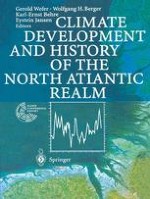2002 | OriginalPaper | Buchkapitel
Holocene Palaeoenvironmental Changes in North-West Europe: Climatic Implications and the Human Dimension
verfasst von : Brian Huntley, Mike Baillie, Jean M. Grove, Claus U. Hammer, Sandy P. Harrison, Stefanie Jacomet, Eystein Jansen, Wibjörn Karlén, Nalân Koç, Jürg Luterbacher, Jörg Negendank, Jörg Schibler
Erschienen in: Climate Development and History of the North Atlantic Realm
Verlag: Springer Berlin Heidelberg
Enthalten in: Professional Book Archive
Aktivieren Sie unsere intelligente Suche, um passende Fachinhalte oder Patente zu finden.
Wählen Sie Textabschnitte aus um mit Künstlicher Intelligenz passenden Patente zu finden. powered by
Markieren Sie Textabschnitte, um KI-gestützt weitere passende Inhalte zu finden. powered by
Holocene climate changes and variability in Europe are outlined on three time scales: long-term changes throughout the period as a whole; shorter-term fluctuations at centennial to millennial scales; and events with an annual to multi-decadal duration. Human population history in Europe during the Holocene is considered in relation to this history of climatic change and variability; in particular, evidence is reviewed that may indicate that human populations responded to, and perhaps also contributed to, climatic changes. The limitations of the data sources and chronological techniques available are briefly outlined.The prevalent long-term pattern is one of relatively warmer conditions during the early to mid-Holocene, temperature subsequently declining towards its present values. Superimposed upon this pattern, however, are marked spatial patterns in the strength of the overall changes, as well as evidence that temperature seasonality varied systematically during the Holocene. No clear patterns in precipitation change emerge at the scale of Europe as a whole; long-term precipitation changes varied both between regions and between seasons. The extent to which human populations responded to these long-term changes, in particular through changes in agricultural practices or settlement patterns, is a matter of ongoing debate.At centennial to millennial scales, numerous independent palaeoclimate sensors provide evidence of variability, with some fluctuations being recorded by many different sensors. A marked cooling event at ca. 8.2 ka BP is widely recorded. Although other fluctuations correlate with less certainty between sensors, a common pattern emerges from many of these records. There is some evidence that these fluctuations may be periodic in character. Although chronological limitations generally preclude making definitive links between records of human populations and those of climatic fluctuations, there are notable coincidences between dates for archaeological events and for climatic fluctuations. In the more recent period, however, especially the last millennium, the link is quite secure between the climatic fluctuations of the ‘Mediæval Warm Period’ and ‘Little Ice Age’, and impacts upon human populations.At the shortest time scales, annual to multi-decadal events are recorded in tree rings and other records that offer annual resolution. The most striking of these events are dramatic, albeit generally short-lived, cooling events; furthermore, at least some of these events were apparently global in extent. Although the cause of these events remains a matter of debate, it seems most probable that they reflect catastrophic events of some nature that resulted in substantial quantities of material being injected into the upper atmosphere, thus reducing penetration of solar radiation for a period of years to a decade or more. Some of these events appear to be recorded in human mythology, and it is apparent that they have often coincided with major events in human history.Although much remains to be discovered, and much further research is required, it is apparent that human populations have been affected by climatic change, variability and events during the Holocene. It is also apparent that, when considered in the context of the Holocene, the twentieth century period of increase in atmospheric concentrations of carbon dioxide and other greenhouse gases, and of the onset of consequent global climatic warming, is anomalous. The predicted rate and magnitude of twenty first century global mean temperature increase will probably exceed anything experienced during the Holocene.
